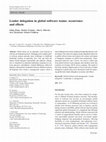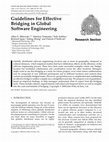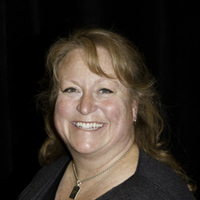Papers by Marilyn Tremaine
... Model of Behavioral Change: Encouraging Adoption of Best Practices Over Standard Practices... more ... Model of Behavioral Change: Encouraging Adoption of Best Practices Over Standard Practices Morgan C. Benton James Madison University bentonmc@jmu.edu Marilyn M. Tremaine Rutgers University marilyn.tremaine@gmail.com ABSTRACT ...

International Journal of Science Education, 2015
The following study investigates the range of strategies individuals develop to infer and interpr... more The following study investigates the range of strategies individuals develop to infer and interpret cross-sections of three-dimensional objects. We focus on the identification of mental representations and problem-solving processes made by 11 individuals with the goal of building training applications that integrate the strategies developed by the participants in our study. Our results suggest that although spatial transformation and perspective-taking techniques are useful for visualizing cross-section problems, these visual processes are augmented by analytical thinking. Further, our study shows that participants employ general analytic strategies for extended periods which evolve through practice into a set of progressively more expert strategies. Theoretical implications are discussed and five main findings are recommended for integration into the design of education software that facilitates visual learning and comprehension.
ABSTRACT It is challenging to search a dictionary consisting of thousands of entries in order to ... more ABSTRACT It is challenging to search a dictionary consisting of thousands of entries in order to select appropriate words for building written communication. This is true both for people trying to communicate in a foreign language who have not developed a full vocabulary, for ...

Electronic Markets, Jan 19, 2012
Global teams are an important work structure in software development projects. Managing such comp... more Global teams are an important work structure in software development projects. Managing such complex global software projects presents many challenges to traditional leadership wisdom, in particular, how, why and when the leaders should delegate responsibility and authority. Delegation is considered an important leadership component to motivate and grow subordinates. Cultural differences, skill level disparity and potential competition between different software development sites creates a management context which is much different from where traditional leadership theories were developed. This study investigates leader delegation behaviors in global software teams and explores the reasons and impact of delegation strategies on global team performance. Semistructured interviews and a survey was used to collect data from global software team managers and members from four countries of a Fortune 100 IT service company. The results of this study include in-depth analysis of hows and whys of leader delegation in global teams and a theoretical model for analyzing global team leader delegation occurrence and effects.

Proceedings Of The Association For Information Science And Technology, 2012
ABSTRACT Three dimensional visualizations are becoming one of the popular web visualization techn... more ABSTRACT Three dimensional visualizations are becoming one of the popular web visualization techniques; however, studies show that for some users, comprehending 3D visualizations is not easy. This research investigated what makes 3D visualizations difficult to understand with the purpose of using this knowledge to develop training to improve visualization literacy. In particular, we focused on the difficulties that individuals have with orientation problems in which they are asked to re-orient themselves to a visual scene from a different viewpoint, something that happens quite often in 3D information visualizations. For our research, we used complex 3D cubes as our experiment problems and sliced the cubes in different ways such that the slices matched the visual orientation a person would naturally take when viewing the slice or required the person to take a different orientation to best determine the features of the slice being made. We then compared performance on recognizing slices that matched a viewer's orientation to that of slices that required a re-orientation. Our results indicated that the problems requiring a reorientation were significantly less accurate.

International Journal of Science Education, Dec 12, 2015
The following study investigates the range of strategies individuals develop to infer and interpr... more The following study investigates the range of strategies individuals develop to infer and interpret cross-sections of three-dimensional objects. We focus on the identification of mental representations and problem-solving processes made by 11 individuals with the goal of building training applications that integrate the strategies developed by the participants in our study. Our results suggest that although spatial transformation and perspective-taking techniques are useful for visualizing cross-section problems, these visual processes are augmented by analytical thinking. Further, our study shows that participants employ general analytic strategies for extended periods which evolve through practice into a set of progressively more expert strategies. Theoretical implications are discussed and five main findings are recommended for integration into the design of education software that facilitates visual learning and comprehension.

CHI is more than a conference, it is an international community of researchers and practitioners ... more CHI is more than a conference, it is an international community of researchers and practitioners who want to make a difference. Everything we do is focused on uncovering, critiquing and celebrating radically new ways for people and technology to evolve together. People in their everyday contexts, in diverse regions of the world, from very different backgrounds, with alternative outlooks on life drive this innovation. As you take part in the conference sessions we really hope you will experience how powerful this people-centred approach to technological transformation can be. CHI as a conference is now in its 32nd year and has grown to become the premier international forum on human-computer interaction, gathering us all to share innovative interactive insights that shape people's lives. CHI draws together a multidisciplinary community from around the globe. Our great strength is our ability to bring together students and experts, researchers and practitioners, scientists, designers and engineers, drawing from their rich perspectives to create new visions of humancomputer interaction. This year's conference theme is One of a CHInd. We chose this nearly two years ago as we began planning for this event. It has helped us focus our efforts and we hope you will use it to keep your eyes open to the bigger picture amongst all the excitement, range of presentations and activities at the conference. CHI 2014 is One of CHInd because it is a celebration of the conference's one of a kind diversity; from the broad range of backgrounds of its attendees, to the diverse spectrum of communities and fields that the conference and its research have an impact on. CHI 2014 will take place at the Metro Toronto Convention Centre in Toronto, Canada, a city itself known for its one of a kind cultural diversity. But, CHI 2014 is more than a celebration of the diversity of our community and conference setting. We hope that this year's event, more than anything, reminds you that the "people," "participants," "users" or "humans" that you hear described throughout this week are actually uniquely wonderful individuals full of hopes, concerns, joys and frustrations. CHI is here to serve all of these one of a kinds. CHI 2014 features two outstanding keynote speakers: Booker prize winning author, Margaret Atwood and leading UX designer, Scott Jenson. New for CHI 2014, we have Provoke! Wisdom! Impact! plenary talks first thing each morning on Tuesday, Wednesday and Thursday. Come along, join the crowd and be energised by our speakers who will each bring in their experience of the Big Picture to inspire us. The talks will be short - twenty minutes - and then the rest of the day's programme will begin. We are also delighted to host a timely retrospective exhibition on wearable technology curated by Thad Starner and Clint Zeagler. CHI 2014 also includes two days of focused workshops and four days of technical content, including CHI's prestigious technical program, with 16 parallel sessions of rigorously reviewed research Papers, engaging Panels, Case Studies and Special Interest Groups (SIGs), an extensive Course program and invited talks from SIGCHI's award winners: Steve Whittaker, Gillian Grampton Smith and Richard Ladner. We also host student research, design, and game competitions, provocative alt.chi presentations and last-minute SIGs for discussing current topics. Interactivity hands-on demonstrations showcase the best of interactive technology. We also highlight over 241 Work-In-Progress posters: this year we have added some features to these sessions to better help you get the most out of the exciting, early stage work on show; do go along and engage with the authors about their work. Evening events include the CHI 2014 conference reception, Sponsors and University events, local performances and the Job Fair. We received over 3200 submissions and accepted nearly 1000 that will appear in the ACM Digital Library. To help you navigate through this immense program, there are a number of online and digital resources from the conference website to our mobile apps. You can also browse the videos, papers and extended abstracts on the CHI 2014 USB Key. But, CHI 2014 is about being in Toronto so perhaps the best way to select from and experience the event is by asking for pointers and chatting with your fellow attendees, our wonderful student volunteers, the information desk helpers or any of this year's committee. We are all here to make your experience as useful and enjoyable as possible. We are deeply indebted to our vast number of volunteers, without whom CHI 2014 would not be possible, including over 3800 reviewers, over 180 senior members of the program committee, nearly 100 members of the CHI 2014 conference committee and, of course, the more than 180 student volunteers. We thank you all! We are honored and excited by the opportunity to host CHI 2014 and wish you a productive and enjoyable stay in Toronto!

Software Process: Improvement and Practice, Nov 1, 2008
Globally distributed software engineering involves one or more of geographic, temporal or cultura... more Globally distributed software engineering involves one or more of geographic, temporal or cultural distances, which empirical studies find have deleterious effects on the efficiency of the software engineering process. There have been some successful examples where one 'bridge' location has facilitated collaboration and coordination across the other locations. Managers might want to use this bridging as a tactic for future projects, even when future collaborations may be composed of very different participants and in different locations and contexts than current successfully bridged teams. However, group behaviour is complicated and establishing an effective bridge is neither a simple nor a straightforward step. We propose a set of guidelines, based on empirical findings, to help managers understand what to expect from the bridging tactic. These include cultural, organizational, individual and temporal factors as well as insights into the costs and benefits of bridging.
AGUFM, Dec 1, 2009
Block diagrams are commonly used to communicate three dimensional geological structures and other... more Block diagrams are commonly used to communicate three dimensional geological structures and other phenomena relevant to geological science (e.g., water bodies in the ocean). However, several recent studies have suggested that these 3D visualizations create difficulties for individuals with low to moderate spatial abilities. We have therefore initiated a series of studies to understand what it is about the 3D
Communications of The ACM, Apr 1, 1988
SIGCHI bulletin, Nov 1, 2000
Global teams are an important work structure in software development projects. However, little is... more Global teams are an important work structure in software development projects. However, little is known about how to handle the conflicting roles a global software team manager should play when delegating. This study investigated delegation practices in global software teams. It ...
Globally distributed software engineering involves one or more of geographic, temporal or cultura... more Globally distributed software engineering involves one or more of geographic, temporal or cultural distances, which empirical studies find have deleterious effects on the efficiency of the software engineering process. There have been some successful examples where one 'bridge' ...
Americas Conference on Information Systems, 2008
... Model of Behavioral Change: Encouraging Adoption of Best Practices Over Standard Practices... more ... Model of Behavioral Change: Encouraging Adoption of Best Practices Over Standard Practices Morgan C. Benton James Madison University bentonmc@jmu.edu Marilyn M. Tremaine Rutgers University marilyn.tremaine@gmail.com ABSTRACT ...
SIGCHI bulletin, Jul 1, 2001
Are we there yet?" I remember this phrase from my childhood when my two brothers and I sat in the... more Are we there yet?" I remember this phrase from my childhood when my two brothers and I sat in the back seat of a 1949 (un-airconditioned) Ford on the long dusty bumpy trip to our summer cottage. If our dog and two cats could talk, I am sure they would have echoed the same sentiments.

SIGCHI bulletin, 2001
In recent years, SIGCHI has experienced significant growth in many new locations, especially Euro... more In recent years, SIGCHI has experienced significant growth in many new locations, especially Europe. The growth outside of North America has been so large, that the SIGCHI Executive Council revisited its policy regarding local SIGs at its August board meeting. The main issue is one of local SIGs forming in new countries. There may already be an organization that claims HCI as one of its primary areas that exists in the country. Thus, chartering a local SIG with SIGCHI may fragment the community and the available volunteers for what could be an already fragile start for HCI. These requests to be a Local SIGCHI SIG when a national HCI organization already exists can happen for a variety of reasons. It may be that a very healthy HCI organization exists, but that a disgruntled offshoot of this group requests to be a Local SIG in SIGCHI because they are unhappy with various policies in their country's organization. HCI may also exist as part of a very traditional ergonomics society with interface designers being chagrined by the group not embracing web design and interaction analysis. They therefore apply to be a Local SIG with SIGCHI in order to interact with a community that is more like they are. It may be that the people making the request do not know about a national organization in their country. It also may be that there are three or four competing organizations within a country, all claiming ownership of HCI with the applicants for a Local SIG seeing this approach as the best way to stay out of the battles. Fortunately, we are seeing the formation of our local SIGs as being quite amicable. Some of them have two affiliations, one within their own country and the local SIG affiliation with SIGCHI. However, we have experienced several instances where this has not been the case and have therefore taken a look at our policy of accepting all applications to be a Local SIG. We created an initial draft that stated that we, as volunteers could not really know what toes we were stepping on. After a large outcry from other national HCI organizations, our October meeting has approved the following policy stating that SIGCHI needs to start behaving more diplomatically. It states: SIGCHI encourages new or existing groups of HCI professionals to become Local SIGs. Before local SIGs are approved, their potential members and area …
SIGCHI bulletin, Jul 1, 2000











Uploads
Papers by Marilyn Tremaine